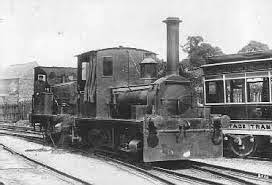WANTAGE TRAMWAY
The roadside tramway never really took off in the UK in the same way it did in other countries. Belgium and the Netherlands were full of them, they were common in France and Germany, they still are common in Switzerland and at one time the USA was networked with interurban tramways.
But we did have a few in the UK. The most famous was probably the Wisbech and Upwell, there was a superb narrow gauge line in Wales (the Glyn Valley Tramway), a few other short stretches of roadside running (on the Nidd Valley Railway for example) and some short stretches of street track, on the Welsh Highland Railway (now running again of course) and the Weymouth Tramway. There were also a good few industrial roadside lines, like the ones on Manchester's Trafford Park for example, and on dock lines throughout the UK.
But rural steam-worked roadside lines were a much rarer thing altogether, and only the Wisbech and Upwell, Glyn Valley Tramway and Wantage Tramway really fall into this bracket.
Possibly the Wantage line was the closest to a classic style line, opening for freight and passenger traffic, and connecting a sizeable town to the nearest junction station on the main line. Although quite successful at first it soon fell victim to heavily subsidised road traffic, and closed to passengers as long ago as 1925. But the line struggled on for freight traffic until 1945. Luckily there are a good number of photographs of this unusual line!
As a model for FUTURE transport the line is a superb example of a cheap, low-impact and low-energy transport system connecting a small town to a main line. How many years before we see a NEW Wantage Tramway?
Further info from Wikipedia
The Wantage Tramway Company was a two mile tramway that carried passengers and freight between the Oxfordshire town of Wantage and Wantage Road Station on the Great Western Main Line. Formed in 1873 to link Wantage Road station with its terminus at Mill Street, Wantage the line was cheaply built parallel to what was then the Besselsleigh Turnpike, and now the A338. The tramway closed to passengers in 1925 and to goods traffic in 1945.
The line was opened for goods on 1 October 1875, and to passengers on 11 October. The tramway junction was to the east of Wantage Road station; interchange passengers walked under the bridge to reach the tramway yard, where the westernmost siding (parallel to the road) was reserved for passenger tramcars.
Built as a standard gauge line, and first run using horse drawn rolling stock, the line became the first to adopt mechanical traction when a steam-powered tramcar, designed by John Grantham, was tried out in the summer of 1875, entering regular service from 1 August 1876. In November that year the first steam locomotive arrived for trials, and the line was converted to steam traction in the late 1870s.
For most of its operation the line was well used and profitable but the advent of popular road transport saw a steady decline in passengers and freight. The tramway closed to passengers on 1 August 1925, and to goods on 22 December 1945.
WTC Locomotive No 5 known on the tramway as 'Jane' but more recently named 'Shannon' and formerly of the Sandy and Potton Railway in Bedfordshire, survives and can be found at the Great Western Society's Railway Centre at Didcot in Oxfordshire.



















Just discovered some film footage date 1936 from British Pathe:
ReplyDeletehttps://www.britishpathe.com/video/wantage-train-on-sleeve-as-wantag-train-issue-titl/query/wantage+tramway
Another image with engine at Grove Bridge:
ReplyDeletehttps://www.rmweb.co.uk/community/uploads/monthly_09_2018/post-34294-0-86895700-1536580427.jpg
Did you know that Jane/Shannon WTCo No.5 appeared on 2 Tuvalu postage stamps?
ReplyDelete